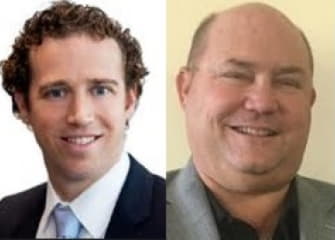
Matt Rothstein and Michael Jessup
The holidays are approaching and before you know it, the end of the year will be here! Now is the perfect time to start planning for your IRA distribution and year-end giving.
As you may know, an individual retirement account (IRA) allows individuals to use pre-tax dollars to save for retirement. Those who are 70½ or older are required to take a minimum distribution from their IRA, whether they need the income or not.
If you are someone who doesn’t need the income, you may want to consider a Qualified Charitable Distribution instead.
We sat down with CPA Matt Rothstein of Rosen, Sapperstein & Friedlander (RS&F), one of the region’s leading business consulting and accounting firms, and Michael Jessup, executive director of Susan G. Komen Maryland, to discuss year-end giving and tax strategies that can benefit you and charitable causes that are important in your life.
What is a Qualified Charitable Distribution?
Matt:A Qualified Charitable Distribution (QCD), commonly called a charitable IRA rollover, allows the IRA owner to donate the IRA required minimum distribution to a charitable organization, avoid the income tax on the withdrawal, and claim a charitable tax deduction on the donation. A QCDis made directly to an eligible charity, bypassing the owner of the account.
How does it work?
Matt:In order to be considered a QCD, your donation must go to a charitable organization that accepts tax-deductible contributions. This does not include private foundations, donor-advised funds, or groups that support tax-exempt charities.
How do I know if I’m eligible?
Matt:You must be at least 70 ½ years of age to contribute some or all of your IRA required minimum distribution to a charity. If you are 70 ½ with a traditional IRA, inactive Simple IRA, inactive SEP-IRA or an inherited IRA, then you are eligible for a QCD.
How much can I transfer from my IRA to a charitable organization?
Matt:You can transfer up to $100,000 per year through a QCD from your IRA to an eligible charity. $100,000 is the maximum amount you can contribute without paying income tax on the transaction. If your spouse is at least 70 ½ and has an IRA, they can also give a maximum of $100,000 from their IRA.
How are charitable organizations making it easier to transfer funds from my IRA?
Michael: You can visit the webpages of many charities for end of the year giving options, such as IRA transfers. Komen Maryland, for example, provides general information about the distribution rules, as well as a sample letter for donors to send to their IRA custodian at https://komenmd.org/options-for-year-end-giving/
How do I report a QCD on my income tax return? What are the filing requirements?
Matt:When reporting a QCD on your Form 1040 tax return, you report the full amount of the donation on the line for IRA distributions. If the full amount of your required minimum distribution went to a qualified charity, you enter zero on the line for taxable amount and write “QCD” beside it.
For a QCD to count toward this year’s required minimum distribution, your contribution must be made by December 31.
What are the benefits and tax saving advantages?
Michael:A QCD can have an immediate impact for the charitable organization and for you.There are three main benefits for you:
- 1.You contribute to the qualified charity or charities of your choosing.
- 2.The amount you choose to contribute counts toward your required minimum distribution.
- 3.The distribution is nontaxable.
The great thing about a QCD is that your donation will be put to use immediately, allowing you to see the difference your donation is making. This tax strategy is a win-win for the individual donating and the charitable organizations benefitting.
I’m under 70 and want to know –what are other ways to give during the holiday season?
Michael:
There are lots of end-of-year giving options and it’s important to determine what type of charitable giving is best for you.
Many people, especially young people, want to donate to charity, but are afraid they can't afford it. Consider a monthly automatic giving option, where a selected amount is charged to your credit or debit card each month. The cost of a couple of cups of coffee each month can add up to a meaningful donation to a charity.
At Komen Maryland, you can also donate your old car, boat, motorcycle—anything with a title. The proceeds from the sale of those items will benefit the charity and may mean a tax deduction for you.
Volunteering your time is also a great way to give back when your budget is tight.
What role does end-of-year giving play in the important work Susan G. Komen Maryland does in breast cancer research and support?
Michael:
An end-of-year donation is that your gift will be put to use today – allowing you to see the difference your donation is making.According to Network for Good, 50 percent of total annual giving for all nonprofit organizations comes from the last three months of the year, making this time of year especially important for charitable organizations.
RS&F –Our team can answer any questions you might have on QCDs and other year-end tax strategies. For more detailed information on tax benefits of charitable giving, please seek the assistance of our business consultants.Contact us at http://rsandf.com/Contact-RS-F/Contact-Us
Susan G. Komen Maryland –If you’re looking for an easy way to contribute one more time before the new year, visit:https://komenmd.org/options-for-year-end-giving/


































